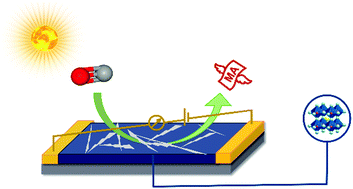Carbon monoxide induced self-doping in methylammonium lead iodide films and associated long-term degradation effects†
Abstract
Interaction with gas molecules at the device interface can critically affect the electro-optical and mechanical properties, and stability of the active materials. While the interaction of abundant gases such as oxygen, nitrogen, and carbon dioxide with lead halide perovskites has been studied with interest, little attention has been paid to the effect of other omnipresent gases such as carbon monoxide (CO) over the perovskite surface. The current work shows that CO has a very strong interaction with methylammonium lead iodide (MAPbI3), a prototypical example of lead halide perovskites, and can displace adsorbed O2. It is observed that exposure to the CO environment leads to a lowering of work function and induces self-doping in the MAPbI3 film. Interaction with CO at the perovskite film interface leads to layer-by-layer depletion of the organic moiety leaving behind PbI2 and this also softens the film over time. While long-duration exposure is detrimental to the electro-optical properties of the perovskite film, short exposure to the CO causes a 122% enhancement in the self-powered capacity of these films, which has significant implications for their applications in photodetectors, electrochemical cells, and sensors.



 Please wait while we load your content...
Please wait while we load your content...